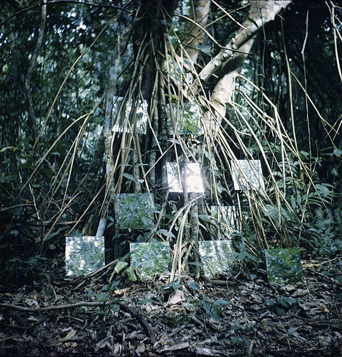
Yucatan Mirror Displacements 1-9, 1969
Robert Smithson
Yucatan Mirror Displacements 1–9, 1969
Nine color prints from color slides (126 format)
61 x 61 cm each
“I’m using a mirror because the mirror in a sense is both the physical mirror and the reflection: the mirror as a concept and abstraction; then the mirror as a fact within the mirror of the concept. So that’s a departure from the other kind of contained, scattering idea. But still the bi-polar unity between the two places is kept.” Robert Smithson, 1969.[1]
The earliest works by Robert Smithson (Passaic, New York, 1938–Amarillo, Texas, 1973) are paintings, drawings and collages that can be grouped together under Abstract Expressionism. However, he soon abandoned two-dimensional work and switched to sculpture, since he felt that pictorial technique limited the growth of his creativity.
In 1963, Smithson married the artist Nancy Holt, and the two of them worked on an artistic project that involved a tour of abandoned places in search of dismantled industries and mines in New Jersey and Pennsylvania, the objective being to generate ideas for their own artworks. Not satisfied with these places, Smithson explored other sites in the west and south-west of the USA, finding a special interest in deserts. The artist would collect gravel, geological remains and fragments of rock from these places and afterwards combine them into geometric sculptures in a minimalist style.
The next year, 1964, Smithson started to produce what he calls his first important works, which use the landscape and nature as their raw material and are regarded as the earliest works of Land Art. Wood, earth, stones, sand, wind, rocks, fire, water and so on became the driving inspiration behind his work, as well as providing the very materials he used to intervene on nature itself.
Most of the Land Art produced by Smithson during his career was site-specific, meaning that each work was designed for a particular outdoor location, creating a hybrid between sculpture and architecture, where landscape always plays a decisive role. In addition, most of these works are ephemeral. Some disappear in time, and nothing remains of them except for a photographic or film record, since their outdoor location exposes them to the changing climate and erosion of their natural surroundings. Other works, like the Yucatan Mirror Displacements (1–9) of 1969, were directly made with the intention of not allowing them to last, as they were dismantled as soon as they had been photographed.[2]
To make Yucatan Mirror Displacements (1–9), Smithson placed nine square mirrors with 30-centimeter sides in nine different landscapes on the Yucatan Peninsula. The result is a series of nine color photographs that Smithson published in the journal Artforum to accompany the text “Incidents of Mirror-Travel in the Yucatan” (1969). The artist saw the mirrors as reflecting and refracting the surroundings, displacing the solidity of the landscape and breaking up its forms. While the mirrors record the passage of time, a photograph of them leaves it suspended, generating a contradiction in the temporality of the work.[3]
Preguntas
Look closely at Robert Smithson’s work. Take time to observe all the details. What do you notice? What natural objects can you make out? Make a list of the things you see. Which do you think form part of the natural world, and which do you think were added by the artist? How do you think he made the work? Describe the process of its composition as he seems to you to have planned it.
In 1969, Smithson traveled to Mexico with his wife Nancy Holt in search of different sites for the creation of artworks. In what kind of landscape do you imagine this photograph was taken? Why? What do you imagine it feels like to be there? What sounds do you think might be heard in this place? What smells might you notice there? Why? Have you ever been to a place like this?
The mirrors of Yucatan Mirror Displacements (1–9) were dismantled after they were photographed by the artist. Why do you think this was done? What do you reckon would have happened otherwise? Can this work be considered ephemeral because the photographed object no longer exists, or do you think, on the contrary, that it can be regarded as permanent because the photograph of it still survives? Give reasons for your answer. How would the work change if Smithson had photographed it in a different place, such as a city?
Robert Smithson is one of the artists most representative of Land Art. Find out about this artistic movement. Why do you think some artists choose landscape as an artistic tool for creating their works? What are the possible advantages and disadvantages of this artistic medium?
This artist is interested in playing with the contradiction between the ephemeral and the permanent. How do you think this contradiction is reflected in Yucatan Mirror Displacements (1–9)? Why do you believe an artist would want to create a temporary artwork? What could be the purpose of inventing a changeable work of art? How would you feel as artists if you made something like that? Do you think it is important to make a record of the work? In your opinion, is the record of such works as important as—or more important than—the creation of the work itself?
